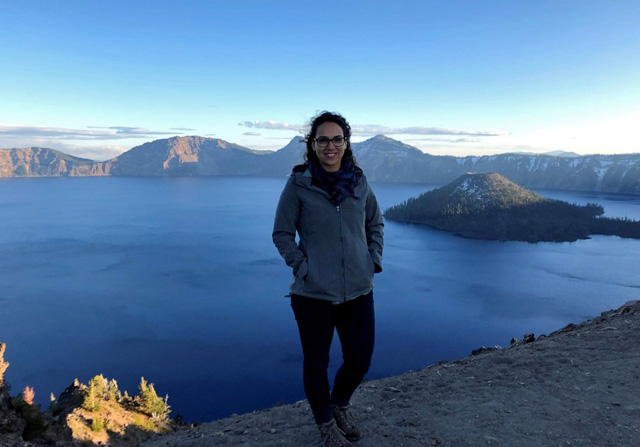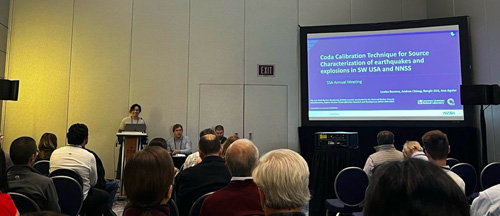16 September 2025—For her dissertation, Louisa Barama worked on ways to characterize seismic events like tsunamigenic and deep earthquakes in near real time, using teleseismic data, calculations of radiated earthquake energy and machine learning techniques.
“Then I got this opportunity to work on an Air Force Research Lab project [led by Zhigang Peng], asking if we can use machine learning to do monitoring and detection of underground nuclear explosions,” she recalls. “I remember my advisor [Andrew Newman at Georgia Tech] said, ‘bear with me, it’s going to be different in some ways, but you’ll be mostly doing the same things.’”

“Getting into the world of nuclear monitoring was just really fascinating and cool, and we ended up having a successful project,” Barama adds. “That’s kind of what opened up opportunities for me with the current position I have as a postdoc at Lawrence Livermore National Lab.”
At LLNL, Barama has expanded the tools and techniques she uses for earthquake and explosion source characterization, gaining a new appreciation for the “full seismogram” and “really learning to have respect for what I had always considered the noise of a signal,” she says.
For instance, a tool developed at LLNL called the Coda Calibration Tool uses seismic coda to determine moment magnitudes for small earthquakes “where we can’t traditionally, with waveform modeling, make these determinations,” she explains.
In her work, Barama is using the tool to characterize small chemical explosions from Nevada’s Nuclear Security Site from the Source Physics Experiments and other ongoing experiments, and she has made a calibration that will be used for Morocco’s national earthquake monitoring (CNRST) and catalog building.
The characteristics that distinguish unique events such as tsunami earthquakes and explosions can be used to guide machine learning models, says Barama. “These are not data sets where we have millions and millions of samples. It’s very limited. But my work has shown that we can apply machine learning even in these cases that are data-limited.”
“For me, I think it’s really important for a machine learning model to be interpretable,” she adds. “We need to really be able to understand what our models are doing, which is an emphasis in the monitoring world.”
Barama is part of a machine learning group that meets twice a month at LLNL to discuss new papers, and she attends workshops to keep up the field more broadly — even data science workshops where the focus (or example problem) is neurology or cancer.
“I am trying to look at fields even outside of seismology and outside of geophysics because ultimately what we’re doing is data science, and we’re just learning different ways to work with our data,” she says.
Barama’s undergraduate advisors were particle and nuclear and molecular physicists, but one of them had a “side hobby” in geophysics that intrigued her, she says. “I like the language of physics to understand the natural world and how things work, but I also wanted to do something that I felt could help people. So geophysics seemed like a good fit.”
“Natural disasters and earthquakes are these huge energetic sources and they affect people all around the world,” she adds. “I’ve always wanted to know more about them and the ways that we characterize and mitigate those risks for people.”
Barama also participates regularly in public outreach, especially with schools, to share what it’s really like to be a scientist.
“If you had asked me when I was a little kid, what I wanted to do, I really had no idea. And I think if you had told my younger self that I was going to be a scientist, I don’t think I would have believed it. I was pretty shy. I didn’t have a lot of confidence. But I learned to excell in topics that I had an inherent curiosity in,” she says.

Some of those similarly curious students she meets today tell her they want to be scientists but are worried that they need to be “a perfect, straight-A student, exceptionally and naturally talented,” says Barama.
“And when I talk to my colleagues, people whose careers I respect and the work that they’ve done, that’s not the path a lot of us have taken … I think it’s really important to educate students about that.”
She tells the students to explore their interests and to remember that “it’s okay to struggle, and just because something doesn’t automatically make sense to you, doesn’t mean it’s a field you can’t pursue. We all struggle at times.”
“I think being a scientist is really cool because I get to follow my curiosity for work,” says Barama. “And then bonus points, it can actually help the world, to understand a bit more about earthquake hazards or how to detect explosions.”
SSA At Work is a monthly column that follows the careers of SSA members. For the full list of issues, head to our At Work page.
